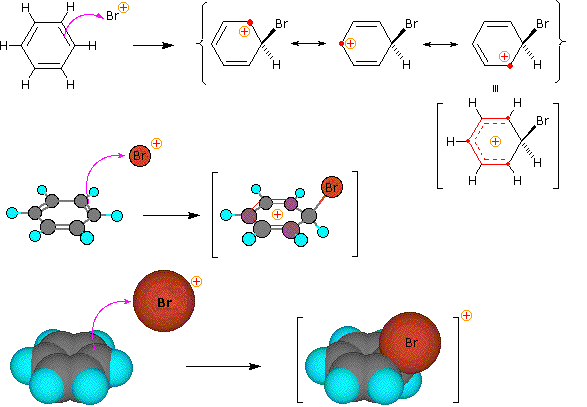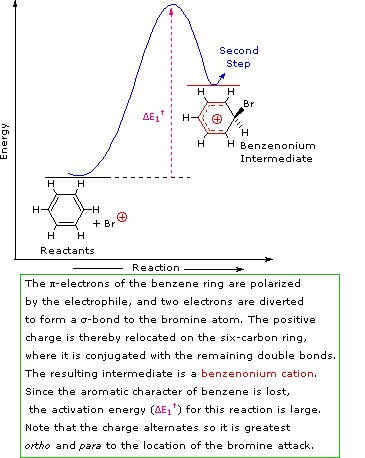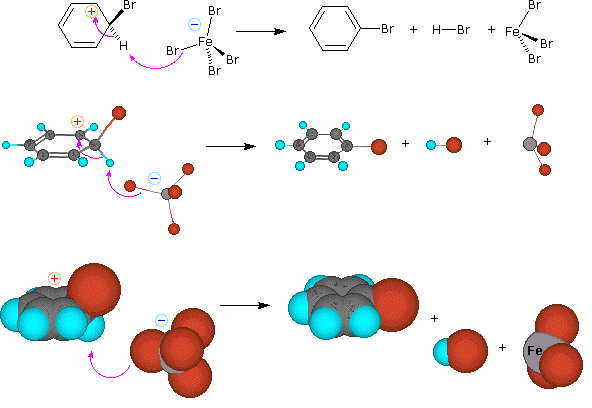19.14: Electrophilic Aromatic Substitution Reactions - Bromination
- Page ID
- 137854
Objectives
After completing this section, you should be able to
- write the detailed mechanism for the reaction of bromine with benzene in the presence of a suitable catalyst.
- draw the resonance contributors for the carbocation which is formed during the reaction of bromine with benzene.
- compare the reaction which takes place between bromine and benzene and the reaction which takes place between bromine and an alkene.
- draw an energy diagram for the reaction of bromine with benzene.
- identify the reagents required to bring about aromatic bromination.
- write an equation to represent aromatic bromination.
Study Notes
The Mechanism for Electrophilic Substitution Reactions of Benzene is the key to understanding electrophilic aromatic substitution. You will see similar equations written for nitration, sulphonation, acylation, etc., with the major difference being the identity of the electrophile in each case.
Note that the carbocation intermediate formed has a number of resonance forms. Also, you may wish to review Section 8.2 to meet Objective 3.
Halogenation is an example of electrophillic aromatic substitution. In electrophilic aromatic substitutions, a benzene is attacked by an electrophile which results in substition of hydrogens. However, halogens are not electrophillic enough to break the aromaticity of benzenes, which require a catalyst to activate.
A Mechanism for Electrophilic Substitution Reactions of Benzene
A two-step mechanism has been proposed for these electrophilic substitution reactions. In the first, slow or rate-determining, step the electrophile forms a sigma-bond to the benzene ring, generating a positively charged benzenonium intermediate. In the second, fast step, a proton is removed from this intermediate, yielding a substituted benzene ring. The following four-part illustration shows this mechanism for the bromination reaction. Also, an animated diagram may be viewed.
Preliminary step: Formation of the strongly electrophilic bromine cation
Step 1: The electrophile forms a sigma-bond to the benzene ring, generating a positively charged benzenonium intermediate
Step 2: A proton is removed from this intermediate, yielding a substituted benzene ring
This mechanism for electrophilic aromatic substitution should be considered in context with other mechanisms involving carbocation intermediates. These include SN1 and E1 reactions of alkyl halides, and Brønsted acid addition reactions of alkenes.
To summarize, when carbocation intermediates are formed one can expect them to react further by one or more of the following modes:
1. The cation may bond to a nucleophile to give a substitution or addition product.
2. The cation may transfer a proton to a base, giving a double bond product.
3. The cation may rearrange to a more stable carbocation, and then react by mode #1 or #2.
SN1 and E1 reactions are respective examples of the first two modes of reaction. The second step of alkene addition reactions proceeds by the first mode, and any of these three reactions may exhibit molecular rearrangement if an initial unstable carbocation is formed. The carbocation intermediate in electrophilic aromatic substitution (the benzenonium ion) is stabilized by charge delocalization (resonance) so it is not subject to rearrangement. In principle it could react by either mode 1 or 2, but the energetic advantage of reforming an aromatic ring leads to exclusive reaction by mode 2 (ie. proton loss).
Problems
1. What reagents would you need to get the given product?

2. What product would result from the given reagents?

3. What is the major product given the reagents below?
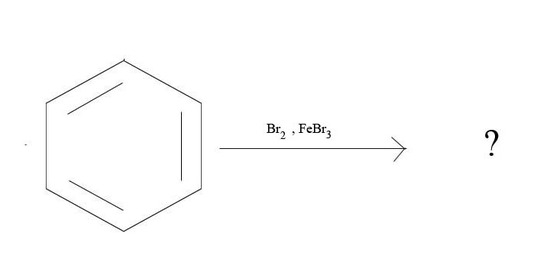
4. Draw the formatin of Cl+ from AlCl3 and Cl2
5. Draw the mechanism of the reaction between Cl+ and a benzene.
Solutions
1. Cl2 and AlCl3 or Cl2 and FeCl3
2. No Reaction
3.
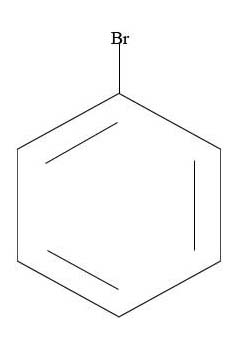
4.

5.
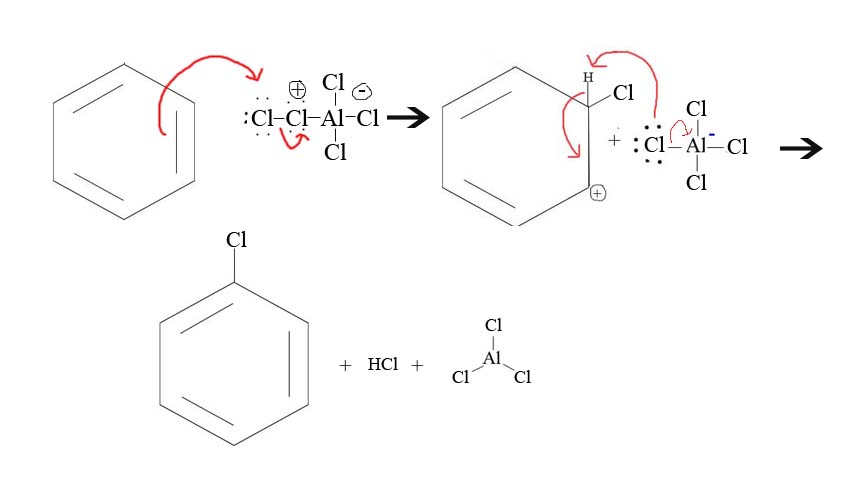
Contributors
Dr. Dietmar Kennepohl FCIC (Professor of Chemistry, Athabasca University)
Prof. Steven Farmer (Sonoma State University)
- Catherine Nguyen
- William Reusch, Professor Emeritus (Michigan State U.), Virtual Textbook of Organic Chemistry




